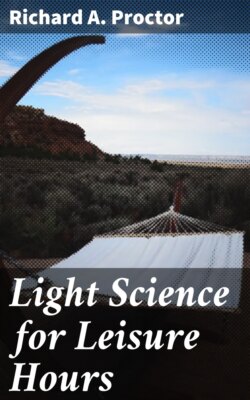Light Science for Leisure Hours

Реклама. ООО «ЛитРес», ИНН: 7719571260.
Оглавление
Richard Anthony Proctor. Light Science for Leisure Hours
Light Science for Leisure Hours
Table of Contents
PREFACE TO FIRST EDITION
STRANGE DISCOVERIES RESPECTING THE AURORA
THE EARTH A MAGNET
OUR CHIEF TIME-PIECE LOSING TIME
ENCKE THE ASTRONOMER
VENUS ON THE SUN’S FACE
BRITAIN’S COAL CELLARS
THE SECRET OF THE NORTH POLE
IS THE GULF STREAM A MYTH
FLOODS IN SWITZERLAND
A GREAT TIDAL WAVE
DEEP-SEA DREDGINGS
THE TUNNEL THROUGH MONT CENIS
TORNADOES
VESUVIUS
THE EARTHQUAKE IN PERU
THE GREATEST SEA-WAVE EVER KNOWN
THE USEFULNESS OF EARTHQUAKES
THE FORCING POWER OF RAIN
A SHOWER OF SNOW-CRYSTALS
LONG SHOTS
INFLUENCE OF MARRIAGE ON THE DEATH-RATE
THE TOPOGRAPHICAL SURVEY OF INDIA
A SHIP ATTACKED BY A SWORD-FISH
THE SAFETY-LAMP
THE DUST WE HAVE TO BREATHE
PHOTOGRAPHIC GHOSTS
THE OXFORD AND CAMBRIDGE ROWING STYLES
BETTING ON HORSE RACES: OR, THE STATE OF THE ODDS
SQUARING THE CIRCLE
A NEW THEORY OF ACHILLES’ SHIELD
FOOTNOTES:
Отрывок из книги
Richard A. Proctor
A series of familiar essays on scientific subjects, natural phenomena, &c
.....
But besides the divergence of a magnetised needle from the north pole, there is a divergence from the horizontal position which must now claim our attention. If a non-magnetic needle be carefully suspended so as to rest horizontally, and be then magnetised, it will be found no longer to preserve that position. The northern end dips very sensibly. This happens in our hemisphere. In the southern, it is the southern end which dips. It is clear, therefore, that if we travel from one hemisphere to the other we must find the northern dip of the needle gradually diminishing, till at some point near the equator the needle is horizontal; and as we pass thence to southern regions, a gradually increasing southern inclination is presented. This has been found to be the case, and the position of the line along which there is no inclination (called the magnetic equator) has been traced around the globe. It is not coincident with the earth’s equator, but crosses that circle at an angle of twelve degrees, passing from north to south of the equator in long. 3° west of Greenwich, and from south to north in long. 187° east of Greenwich. The form of the line is not exactly that of a great circle, but presents here and there (and especially where it crosses the Atlantic) perceptible excursions from such a figure.
At two points on the earth’s globe the needle will rest in a vertical position. These are the magnetic poles of the earth. The northern magnetic pole was reached by Sir J. G. Ross, and lies in 70° N. lat. and 263° E. long., that is, to the north of the American continent, and not very far from Boothia Gulf. One of the objects with which Ross set out on his celebrated expedition to the Antarctic Seas was the discovery, if possible, of the southern magnetic pole. In this he was not successful. Twice he was in hopes of attaining his object, but each time he was stopped by a barrier of land. He approached so near, however, to the pole, that the needle was inclined at an angle of nearly ninety degrees to the horizon, and he was able to assign to the southern pole a position in 75° S. lat., 154° E. long. It is not probable, we should imagine, that either pole is fixed, since we shall now see that the inclination, like the declination of the magnetic needle, is variable from time to time, as well as from place to place; and in particular, the magnetic equator is apparently subjected to a slow but uniform process of change.
.....